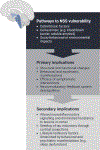Priorities for research on neuromodulatory subcortical systems in Alzheimer's disease: Position paper from the NSS PIA of ISTAART
- PMID: 36642985
- PMCID: PMC10182252
- DOI: 10.1002/alz.12937
Priorities for research on neuromodulatory subcortical systems in Alzheimer's disease: Position paper from the NSS PIA of ISTAART
Abstract
The neuromodulatory subcortical system (NSS) nuclei are critical hubs for survival, hedonic tone, and homeostasis. Tau-associated NSS degeneration occurs early in Alzheimer's disease (AD) pathogenesis, long before the emergence of pathognomonic memory dysfunction and cortical lesions. Accumulating evidence supports the role of NSS dysfunction and degeneration in the behavioral and neuropsychiatric manifestations featured early in AD. Experimental studies even suggest that AD-associated NSS degeneration drives brain neuroinflammatory status and contributes to disease progression, including the exacerbation of cortical lesions. Given the important pathophysiologic and etiologic roles that involve the NSS in early AD stages, there is an urgent need to expand our understanding of the mechanisms underlying NSS vulnerability and more precisely detail the clinical progression of NSS changes in AD. Here, the NSS Professional Interest Area of the International Society to Advance Alzheimer's Research and Treatment highlights knowledge gaps about NSS within AD and provides recommendations for priorities specific to clinical research, biomarker development, modeling, and intervention. HIGHLIGHTS: Neuromodulatory nuclei degenerate in early Alzheimer's disease pathological stages. Alzheimer's pathophysiology is exacerbated by neuromodulatory nuclei degeneration. Neuromodulatory nuclei degeneration drives neuropsychiatric symptoms in dementia. Biomarkers of neuromodulatory integrity would be value-creating for dementia care. Neuromodulatory nuclei present strategic prospects for disease-modifying therapies.
© 2023 The Authors. Alzheimer's & Dementia published by Wiley Periodicals LLC on behalf of Alzheimer's Association.
Conflict of interest statement
Disclosures
AJE has received support for travel from the Rainwater Charitable Foundation and Deutsches Zentrum für Neurodegenerative Erkrankungen, has received consulting fees from Epiodyne Inc., holds stock in Eiger Biopharmecuticals, is a Science Editor for “Alzheimer’s & Dementia: The Journal of the Alzheimer’s Association”, and serves on the executive committee for the Neuromodulatory Subcortical Systems PIA of ISTAART. ST is an advisory board member for Roche, Eisai, Biogen, and Grifols and is an independent data monitoring board member for Biogen, is a senior associate editor for “Alzheimer’s & Dementia: The Journal of the Alzheimer’s Association”, and served on the executive committee for the Neuromodulatory Subcortical Systems PIA of ISTAART during the time this manuscript was written. AIL has received consulting fees from Biogen, Karuna, Cognito Theraputics, and Genuv. QW is listed on US Patent applications 63/138.118 & 63/305.621, and holds stock in Terran Biosciences. CB has received consulting fees from Cyclerion Theraputics, serves on the steering committee of the Italian Society of Psychophysiology, and serves as the immediate past chair of the Electrophysiology PIA of ISTAART. LTG has received support from the Rainwater Charitable Foundation, support for travel from the Alzheimer’s Association, and serves on the executive committee for the Neuromodulatory Subcortical Systems PIA of ISTAART. HILJ, MJD, AJW, DW, NF, SEC, CS, MK, and GS served on the executive committee (unpaid) for the Neuromodulatory Subcortical Systems PIA of ISTAART during the time this manuscript was written. KL, MM, MJB, SD, DH, JRW, MLe, JMS, OE, IR, EL, MLu, CS, MVE, EMV, FR, LH, SV, WMF, YY, MM, CL, MB, AS, JRG, WSK, and RH have no conflicts to disclose.
Figures

References
-
- Azevedo FA, Carvalho LR, Grinberg LT, Farfel JM, Ferretti RE, Leite RE, et al. Equal numbers of neuronal and nonneuronal cells make the human brain an isometrically scaled-up primate brain. J Comp Neurol 2009;513:532–41. - PubMed
-
- Bargmann CI, Marder E. From the connectome to brain function. Nat Methods 2013;10:483–90. - PubMed
-
- Whitehouse PJ, Price DL, Struble RG, Clark AW, Coyle JT, Delon MR. Alzheimer’s disease and senile dementia: loss of neurons in the basal forebrain. Science 1982;215:1237–9. - PubMed
-
- Curcio CA, Kemper T. Nucleus raphe dorsalis in dementia of the Alzheimer type: neurofibrillary changes and neuronal packing density. J Neuropathol Exp Neurol 1984;43:359–68. - PubMed
Publication types
MeSH terms
Substances
Grants and funding
- U54 AG065187/AG/NIA NIH HHS/United States
- P30 AG066511/AG/NIA NIH HHS/United States
- P30 AG062429/AG/NIA NIH HHS/United States
- R01 AG060477/AG/NIA NIH HHS/United States
- RF1 AG056573/AG/NIA NIH HHS/United States
- R01 AG070826/AG/NIA NIH HHS/United States
- R01 AG060731/AG/NIA NIH HHS/United States
- R01 AG025340/AG/NIA NIH HHS/United States
- RF1 AG056815/AG/NIA NIH HHS/United States
- R01 AG064664/AG/NIA NIH HHS/United States
- R01 AG078191/AG/NIA NIH HHS/United States
- R01 AG062559/AG/NIA NIH HHS/United States
- RF1 AG067729/AG/NIA NIH HHS/United States
- K24 AG053435/AG/NIA NIH HHS/United States
- P30 AG066515/AG/NIA NIH HHS/United States
- F32 AG074625/AG/NIA NIH HHS/United States
- RF1 AG061175/AG/NIA NIH HHS/United States
- MR/S021418/1/MRC_/Medical Research Council/United Kingdom
- T32 GM139780/GM/NIGMS NIH HHS/United States
- U01 AG061357/AG/NIA NIH HHS/United States
- R21 AG074220/AG/NIA NIH HHS/United States
- P30 AG066546/AG/NIA NIH HHS/United States
- R01 AG064314/AG/NIA NIH HHS/United States
- R01 AG076838/AG/NIA NIH HHS/United States
- R01 AG068062/AG/NIA NIH HHS/United States
- R01 AG062581/AG/NIA NIH HHS/United States
- P30 AG072931/AG/NIA NIH HHS/United States
- U01 AA025481/AA/NIAAA NIH HHS/United States
- F31 AG069502/AG/NIA NIH HHS/United States
- K23 AG058805/AG/NIA NIH HHS/United States
- R01 AG050595/AG/NIA NIH HHS/United States

